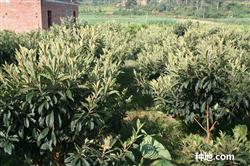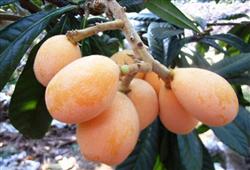How can loquat trees be planted with high yield?
How can loquat trees be planted with high yield? How do you need to manage? Loquat fruit ripens in early summer in the off-season of fruit supply. The improved variety of loquat can be put into production for 2-3 years, with a yield of about 1500 kg per mu and an income of more than 10,000 yuan. 1. According to the market demand for improved varieties of big loquat and the local planting conditions, we choose the precocious red meat type of large loquat with sweet fruit, high quality and high yield. There are Mori Zaosheng loquat, which matured in late April, and Dawuxing, Longquan No. 1, Jiefang Zhong, which matured in the first and middle of May. Second, the establishment and planting of the garden should choose flat land or gentle slope land with convenient transportation and deep soil layer. First of all, in the garden according to the conventional planting of 4X3 rice or planned close planting of 3X2 rice row, the plant distance from the fixed point, deep digging (or bottom blasting) into a width of about 1 meter, 0.8 meters deep planting trench or 1 meter square planting nest, per mu into mature garbage and miscellaneous plots and other organic fertilizer 10, 000 kg, and soil backfill in the ditch (nest). Secondly, plant seedlings after it rains in autumn (September-October) or spring (February-March). Generally planting 60 trees per mu, and planning to plant about 100 plants per mu. When planting loquat seedlings, they should be graded according to size and transplanted with clusters, and irrigated with sufficient root water, which is beneficial to survival. Third, rational fertilization is the supporting period of loquat seedlings within 3 years after planting, mainly by vegetative growth to expand the crown. Fertilization to achieve "light fertilizer application frequently, promote before and control after". Before and after sprouting spring shoots, summer shoots and autumn shoots, the fertilizer of promoting shoots and strong shoots were applied once a year for 8 times a year. Each time, 10 kg of water and fertilizer for mature human livestock and poultry were applied each time, and urea was added to 100 g of urea. As a result, the loquat orchard was fertilized 4 times a year, and the base fertilizer after fruit harvest from May to June was re-applied. Each plant was deeply fertilized with 40kg water fertilizer for mature human livestock and poultry, mixed with cruller (withered) fertilizer 1Mel 2kg and calcium superphosphate 1kg, and timely applied pre-flowering fertilizer from September to October, spring fertilizer from February to March and strong fruit fertilizer in April. 4. Shaping and pruning according to the characteristics that loquat is easy to branch, central trunk and obvious layer, the tree crown adopts trunk stratification. The method is as follows: after the strong loquat seedlings are planted, the top is cut and the stem is fixed on the trunk about 50 cm above the ground. when sprouting in spring, one strong bud growing upward and five lateral buds in different directions are selected and cultivated into the central trunk and several main branches. by means of pulling, brace and hanging, the angle of the main branch is opened to make it grow diagonally (or horizontally) to form the first layer branch. according to this method, the second and third layer branches are cultivated. The central trunk of more than three layers of branches will be happy, and the height of the crown will be controlled at about 3 meters. Results the loquat orchard can be pruned in summer and before sprouting in spring from May to June after fruit harvest. It is mainly to remove dense branches, bald branches and disease center insect branches in Sichuan and truncate perennial declining branches and shade branches to renew and rejuvenate the tree. In addition, from July to August in the first year of flowering and fruiting in the fourth year of planting young loquat trees, measures such as nitrogen fertilizer control, moisture control and shaping and branching were adopted to promote early flowering and fruiting. 5. Flower and fruit management after entering the fruiting stage, loquat blossoms more, so it should be thinning flowers and fruits. In October before flowering, for trees with a large amount of flowers, the weak flower branches, early flowers, and disease and insect flowers are all cut off; generally, trees with sparse flowers and fruits account for about 50% of the whole tree. Fruit thinning is generally carried out in the young fruit stage in mid-March, first removing frozen damaged fruit, deformed fruit and disease and insect fruit, and then thinning overdense small fruit. In general, it is suitable for large fruit type varieties to leave 3 fruits per panicle and 4 fruit per panicle for small fruit type varieties. After fruit thinning, bagging the fruit with old newspapers and Kraft paper can improve the fruit quality. Sixth, the control of metallurgical pests loquat seedling stage, from March to September every year, focus on the control of aphids, pear heart borer and peach borer, etc. In the adult loquat orchard, on the basis of brushing the trunk of Keji tree and baking the disease and insect branches, during the period of new shoots and flowering and fruiting, the crown sprayed Boyuojujun (1%) or 50% topiramate, or 65% zinc, and then added 5% enemy to kill, 20% to clean or nail borer pine emulsion, which can effectively control loquat leaf spot, anthracnose, yellow caterpillar, pear heart borer, peach borer and other diseases and insect pests. Seventh, timely harvest loquat has no post-ripening, fresh food must be picked in batches when the fruit is fully ripe, so as to select ripe loquat and leave it green. When the fresh fruit is exported or transported over a long distance, it can be harvested when the fruit is ripe in 8Mel 9. Click to see more loquat planting techniques click to see more fruit planting techniques
- Prev

How to control diseases and insect pests in loquat trees?
How to control diseases and insect pests by planting loquat? In what season, we should pay more attention to the prevention and control of anthracnose and pear heart borer in loquat planting. 1. Anthrax is mainly harmful to fruits, and leaves and shoots are also seriously damaged in some years. Some years of the disease are very serious, some years are very light. The first disease of the fruit.
- Next

How does Loquat-Shaped Cake plant out of season?
How does Loquat-Shaped Cake grow out of season? What should I pay attention to? Off-season loquat (also known as Spring Festival No. 1, Xingning No. 1) is a very precocious loquat variety. Under better management conditions, it generally bears fruit 2-3 years after planting. The main points of cultivation are as follows: 1. Garden establishment and cultivation: mountain garden construction should open a good ladder soil and dig a good planting pit.
Related
- Moge, come on! The staff of the peasant association in the producing area of cantaloupe were frightened when the crowd gathered.
- Causes and Solutions of low Fruit setting rate of Apple
- Symptoms and control measures of passion fruit virus disease
- Fruit growing lesson: how do apple orchards keep high yields?
- Can you build orchards in the mountains? What are the pros and cons?
- How to manage the coloring period of Crisson grape?
- This paper introduces the processing technology of two kinds of fig products.
- How much is a month for retired teachers in rural areas by 2020?
- How can strawberry planting increase sugar content? We should pay attention to management in many aspects.
- What are the cultivation techniques on how to improve the yield of golden fruit?

